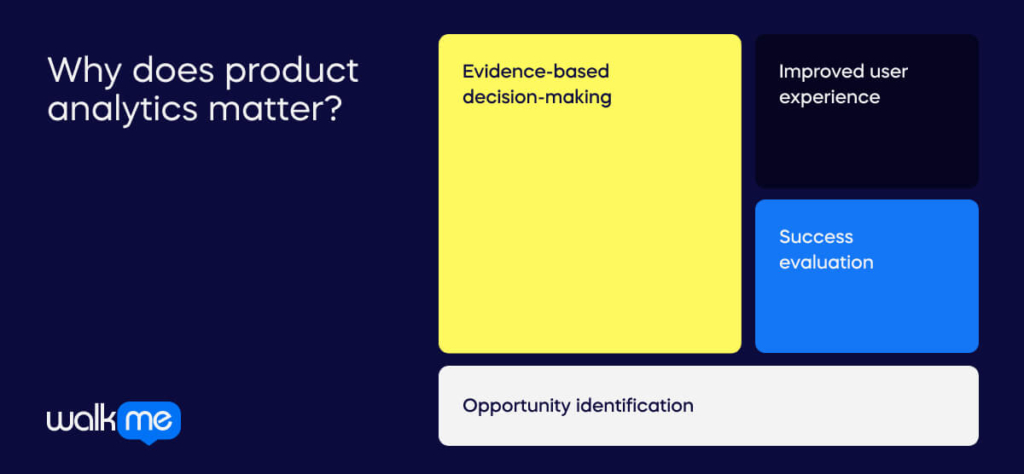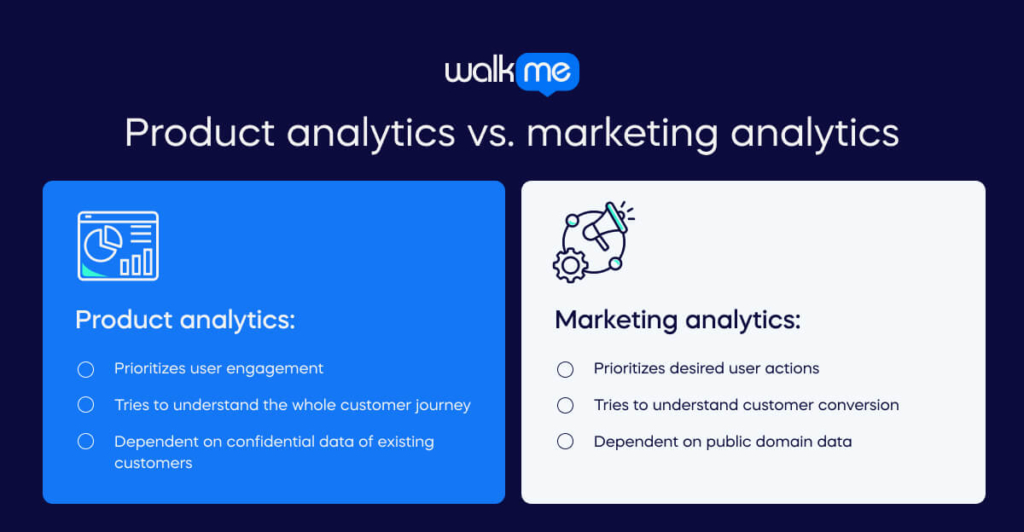What good is a product if it looks great on paper but doesn’t meet a customer’s needs?
These questions are what product analytics seeks to answer to ensure every product hits the mark every time throughout an often slow, iterative process of acquiring business intelligence to meet customer needs accurately.
Data is a vast market, as companies accept that there is often a gap between theory and practice when designing new products and services. As a result, the global big data market will likely reach over USD 68 billion by 2025.
When enterprises analyze product data, they increase their chances of creating successful products by putting their customers first, bridging the gap between them and their users and making customer experience the core of company culture.
This article will explore product analytics, delving into its definition, distinguishing it from marketing analytics, understanding its significance, examining its role in product management, unraveling the benefits of product reporting, and finally, exploring how a Digital Adoption Platform (DAP) can optimize the utilization of product analytics.
What is product analytics?
Product analytics collects and analyzes how users interact with a product or service. It allows teams to monitor, visualize, and analyze user engagement and behavior data, optimizing products or services.
Centered on users, the process shifts focus from a product’s intended purpose to how users interact with products to bridge the gap between design and reality. This approach empowers product managers to derive precise insights for improvement, moving beyond guesswork and instinct alone and allowing them to create products that meet user needs.
Why does product analytics matter?

Product analytics matter for many reasons, as they help paint an image of what customers want and how these needs change over time.
Product analytics matters due to the following reasons:
- Evidence-based decision-making: Leveraging data-driven insights empowers Product Managers to make informed choices regarding product features, prioritization, and resource allocation.
- Improved user experience: A deep understanding of user behavior and preferences enables product managers to customize products, address customer needs, and enhance the overall user experience.
- Success evaluation: Utilizing data analytics, Product Managers can continuously monitor key performance indicators (KPIs) and assess the long-term success of their products.
- Opportunity identification: Through data analysis, Product Managers can unearth new market opportunities, identify trends, and stay ahead of competitors in a dynamic business landscape.
Consider these reasons why product analytics is essential when deciding whether you must invest in it or not.
Product analytics vs. marketing analytics

Even though the phrases ‘product analytics’ and ‘marketing analytics’ are sometimes used as synonyms, this is not always the case. However, the two concepts are closely interlinked. Below are the main differences between the two concepts:
product analytics infographic
Product analytics:
Prioritizes user engagement
Tries to understand the whole customer journey
Dependent on confidential data of existing customers
Marketing analytics:
Prioritizes desired user actions
Tries to understand customer conversion
Dependent on public domain data
Ultimately, marketing analytics focuses on turning visitors into paying users throughout their customer journey. In contrast, product analytics seeks ways to increase customer engagement so that they will keep coming back to the product.
How do product managers use analytics?
Effectively integrate data analytics into product management with these best approaches, like defining goals, using metrics, and maintaining data integrity as part of the best decision intelligence practices.
Define clear goals and metrics
Before delving into data analytics, product managers meticulously define explicit goals and metrics harmoniously with their product vision.
Doing so involves establishing Key Performance Indicators (KPIs) and setting metric targets to gauge product success comprehensively. These metrics serve as benchmarks, enabling product managers to make informed, data-driven decisions aligning with their objectives.
Example product analytics metrics include:
- Conversion rate: Percentage of users completing a desired action, measuring effectiveness.
- Churn rate: Rate at which customers discontinue product use, indicating retention health.
- Average revenue per user (ARPU): Metric: Revenue generated per user, gauging customer value.
- Session duration: Average time users spend interacting with the product per session.
- Customer acquisition cost (CAC): Expenses incurred to acquire a new customer, assessing marketing efficiency.
Gather and maintain high-quality data
Successful data analytics relies on accurate, high-quality data, and the value of the data is high, as 91.9% of organizations achieved measurable value from data and analytics investments in 2023.
Product managers collect data from reliable sources, ensure consistency, and regularly clean data to eliminate duplicates, inaccuracies, and obsolete information.
Select appropriate analytics tools
Managers choose analytics tools that align with their product goals and team capabilities.
Options range from user-friendly or advanced analytics platforms like:
- Google Analytics (user-friendly).
- Mixpanel (advanced).
- Amplitude (advanced).
- Looker (advanced).
The best product managers opt for a tool that meets your requirements and can scale with your product and organization.
Cultivate a Data-Driven Culture
Effective product managers go beyond incorporating data analytics; they actively cultivate a data-driven mindset within their teams.
Integrating data into decision-making fosters a culture of curiosity, experimentation, and continuous learning. Empowering team members to make informed, data-driven decisions enhances adaptability and responsiveness to evolving market dynamics.
Visualize and Communicate Data Insights
Managers employ data visualization tools to interpret intricate data sets to enhance comprehension and alignment. These tools aid in identifying trends, patterns, and anomalies, making complex data more accessible.
By presenting data visually, product managers effectively communicate insights to their teams and stakeholders, facilitating a shared understanding that leads to more informed decision-making.
What are the 6 benefits of product reporting?

Product reporting has six main benefits. Reporting how successful a product is allows enterprises to adjust their products to meet consumer demands more accurately.
1. Comprehensive KPI insights & accurate progress tracking
The primary aim of a product report is to empower informed decision-making regarding your products. It should offer detailed insights into each key performance indicator (KPI) you aim to monitor. Additionally, it provides accurate progress reports, allowing you to assess the effectiveness of your actions.
2. Comprehend product sales data
Integral to product management is monitoring sales performance. Identify top-performing products and understand the reasons behind their success. Product reports answer critical questions about popularity and demand trends, helping you adjust production and improve or introduce new product lines based on consumer needs.
3. Analyze product costs
Beyond overall product sales, comprehensive cost breakdowns are crucial for profitability assessment. Product reports enable a detailed examination of costs, revealing factors that may impact pricing or reduce profitability. This insight ensures accurate business evaluation.
4. Understand customer needs
A product’s success hinges on meeting market needs. B2B subscription reporting facilitates the identification of consumer purchase trends, guiding decisions on production adjustments and new product releases based on consumer preferences.
5. Precise Cohort Analysis
Collecting data is one thing; extracting actionable insights is another. Cohort analysis, facilitated by product reports, involves grouping data based on common characteristics, making data analysis and pattern identification more accessible.
These reports contribute to better user behavior tracking, enhancing retention efforts.
6. Accurate and up-to-date product performance view
Product and sales reports provide invaluable product data, offering an up-to-date perspective on product performance. Doing so ensures informed decision-making, instilling confidence in product teams through reliable information.
How can a DAP optimize product analytics?
When implementing product analytics, you must first consider the necessary tools. A DAP (digital adoption platform) supports product analytics practices in many ways, as you can discover below.
Enhanced user onboarding and training
A Digital Adoption Platform (DAP) proves invaluable for product analytics by streamlining user onboarding and training processes. Through interactive guidance and tutorials, it ensures users quickly grasp product features and functionalities.
It accelerates the learning curve and contributes to more effective product utilization, generating rich data for analysis.
Real-time user engagement insights
One of the key benefits of integrating a Digital Adoption Platform into product analytics is the ability to capture real-time user engagement data when employees are using new software.
The platform monitors user interactions within the product, providing insights into feature usage, navigation patterns, and areas of frequent engagement. This granular data enhances the depth of product analytics, enabling product managers to make informed decisions based on current user behavior.
Data-driven feature adoption strategies
Digital Adoption Platforms empower product managers with data-driven insights to refine feature adoption strategies. Product teams can prioritize development efforts by understanding which features are widely adopted and which may require further attention and improvement.
This action ensures that resource allocation is efficient, focusing on enhancements that align with user preferences and contribute to overall product success. Integrating a DAP into product analytics optimizes user experiences and drives strategic decisions based on real-time, user-centric data.
Use product analytics to prioritize the user at every step
Leverage product analytics to prioritize the user throughout every stage of development. By employing data-driven insights, product teams can identify user preferences, track engagement patterns, and refine features to align with user needs.
This user-centric approach ensures that product decisions are informed by real-time data, ultimately leading to enhanced user satisfaction and increased product success.

